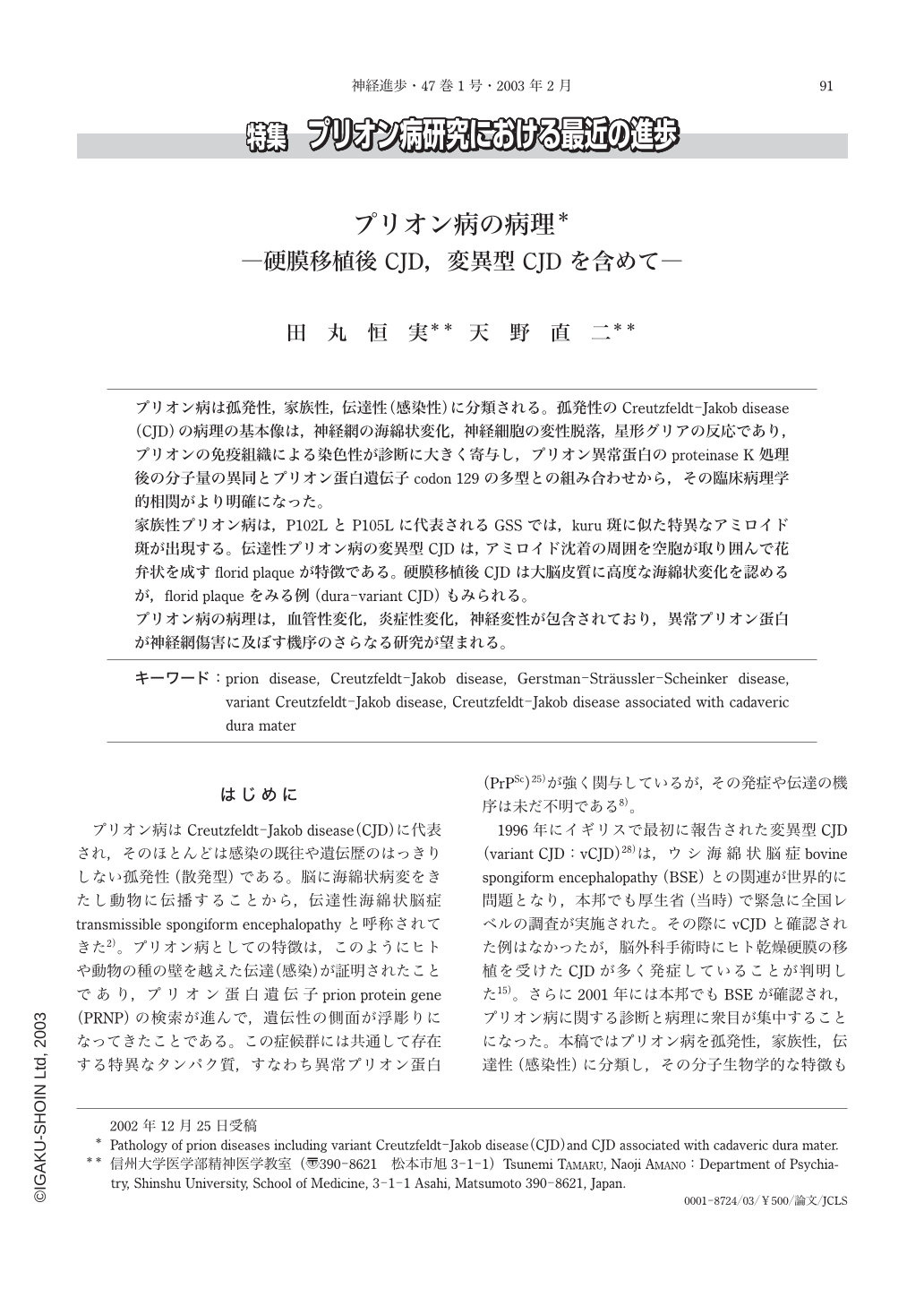Japanese
English
- 有料閲覧
- Abstract 文献概要
- 1ページ目 Look Inside
プリオン病は孤発性,家族性,伝達性(感染性)に分類される。孤発性のCreutzfeldt-Jakob disease(CJD)の病理の基本像は,神経網の海綿状変化,神経細胞の変性脱落,星形グリアの反応であり,プリオンの免疫組織による染色性が診断に大きく寄与し,プリオン異常蛋白のproteinase K処理後の分子量の異同とプリオン蛋白遺伝子codon 129の多型との組み合わせから,その臨床病理学的相関がより明確になった。
家族性プリオン病は,P102LとP105Lに代表されるGSSでは,kuru斑に似た特異なアミロイド斑が出現する。伝達性プリオン病の変異型CJDは,アミロイド沈着の周囲を空胞が取り囲んで花弁状を成すflorid plaqueが特徴である。硬膜移植後CJDは大脳皮質に高度な海綿状変化を認めるが,florid plaqueをみる例(dura-variant CJD)もみられる。
プリオン病の病理は,血管性変化,炎症性変化,神経変性が包含されており,異常プリオン蛋白が神経網傷害に及ぼす機序のさらなる研究が望まれる。
はじめに
プリオン病はCreutzfeldt-Jakob disease(CJD)に代表され,そのほとんどは感染の既往や遺伝歴のはっきりしない孤発性(散発型)である。脳に海綿状病変をきたし動物に伝播することから,伝達性海綿状脳症transmissible spongiform encephalopathyと呼称されてきた2)。プリオン病としての特徴は,このようにヒトや動物の種の壁を越えた伝達(感染)が証明されたことであり,プリオン蛋白遺伝子prion protein gene(PRNP)の検索が進んで,遺伝性の側面が浮彫りになってきたことである。この症候群には共通して存在する特異なタンパク質,すなわち異常プリオン蛋白(PrPSc)25)が強く関与しているが,その発症や伝達の機序は未だ不明である8)。
1996年にイギリスで最初に報告された変異型CJD(variant CJD:vCJD)28)は,ウシ海綿状脳症bovine spongiform encephalopathy(BSE)との関連が世界的に問題となり,本邦でも厚生省(当時)で緊急に全国レベルの調査が実施された。その際にvCJDと確認された例はなかったが,脳外科手術時にヒト乾燥硬膜の移植を受けたCJDが多く発症していることが判明した15)。さらに2001年には本邦でもBSEが確認され,プリオン病に関する診断と病理に衆目が集中することになった。本稿ではプリオン病を孤発性,家族性,伝達性(感染性)に分類し,その分子生物学的な特徴も踏まえながら概説する。
Prion diseases include sporadic CJD of obscure infectious and genetic origins, infectious diseases such as variant CJD, CJD after dura transplantation and kuru, and familial inherited diseases. The main histological features of prion diseases are spongiform change, marked neuronal loss and astrogliosis. Anti-prion staining reveals synaptic and plaque types of abnormal prion protein deposits. Sporadic CJD shows synaptic type in most cases, but sometimes plaque type. Sporadic CJD has been classified by different molecular weights of abnormal prion proteins after proteinase K treatment, that is type 1(21 kD protein without a sugar chain)and type 2(19 kD molecular weight),and the polymorphic types of codon 129(M or V)of prion protein gene. The groups are respectively called MM1, MV1, MM2, MV2 and VV2, the phenotypes of which have been examined clinicopathologically.
Many postoperative patients, particularly in Japan, developed CJD after receiving artificial dura mater. They developed classic CJD(dura-classic type)or CJD with plaque type(dura-variant). Variant CJD has not been reported in Japan. Numerous “florid plaques” appear in the cerebral cortex. In addition to synaptic-type deposits, amyloid deposits occur, ranging widely from confluent, large plaques to characteristic petal-shaped florid plaques resembling chrysanthemums. Kuru was seen in native tribes of Papua New Guinea, and transmitted human-to-human through ritualistic cannibalism. The main lesion is cerebellar degeneration, with kuru plaques in cerebellar granular layers. Kuru plaques are composed of aggregates of radially arranged amyloid fibers with no degeneration of radiating spikes at the periphery.
Mutations in prion protein gene coding for 253 amino acids cause inherited prion disease, each resulting in clinicopathologically characteristic phenotypes. Fifteen different point mutations and 8 different insertion mutations have been reported. Familial CJD is characterized by substitution mutations in codons 180, 200, and 210. Similar to classic MM1-type sporadic CJD, the lesions show synaptic-type prion deposits with marked spongiform degeneration, marked neuronal loss and fibrillary gliosis in cerebral cortex, striate body, and thalamus. In classic Gerstmann-Sträussler-Scheinker disease(GSS)with a mutation in codon 102, numerous amyloid plaques resembling kuru plaques appear in cerebellar and cerebral cortices. Spongiform change in cerebral cortex is seen in varying degrees. The degree of neuronal loss and fibrillary gliosis, observed in cerebellar and cerebral cortices and striate body, varies with patients. In GSS associated with codon 105mutation, numerous amyloid plaques similar to kuru plaques are also found in cerebral and cerebellar cortices, but cerebellar lesions are mild. Basically, no spongiform change is observed in cerebral cortex. Fatal familial insomnia with a substitution mutation of codon 178 is known, and the main lesion is thalamic degeneration. Neuronal loss and fibrillary gliosis are virtually confined to thalamic nuclei and inferior olivary nucleus. Abnormal prion proteins are often difficult to demonstrate.
As described above, the histopathology of definitively diagnosed prion diseases is diverse. In summary, abnormal prion proteins deposit diffusely, in aggregates, or in plaques. hese deposits trigger severe degeneration in neural nets. Small spongiform vacuoles appear in gray matters, and grow coarse. Eventually, spongiform change is completed. O n the other hand, astroglial reaction is also diverse. Advanced fibrillary gliosis is seen in some areas, while in other areas, changes reflect the acute phase in which gemistocytic astrocytes and phagocytes appear. Prion diseases are serious conditions presenting with extensive, progressive lesions throughout the entire brain:the cerebral cortex and white matter, diencephalon, basal ganglia, and cerebellum.

Copyright © 2003, Igaku-Shoin Ltd. All rights reserved.


